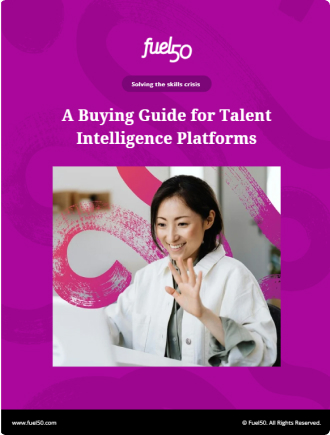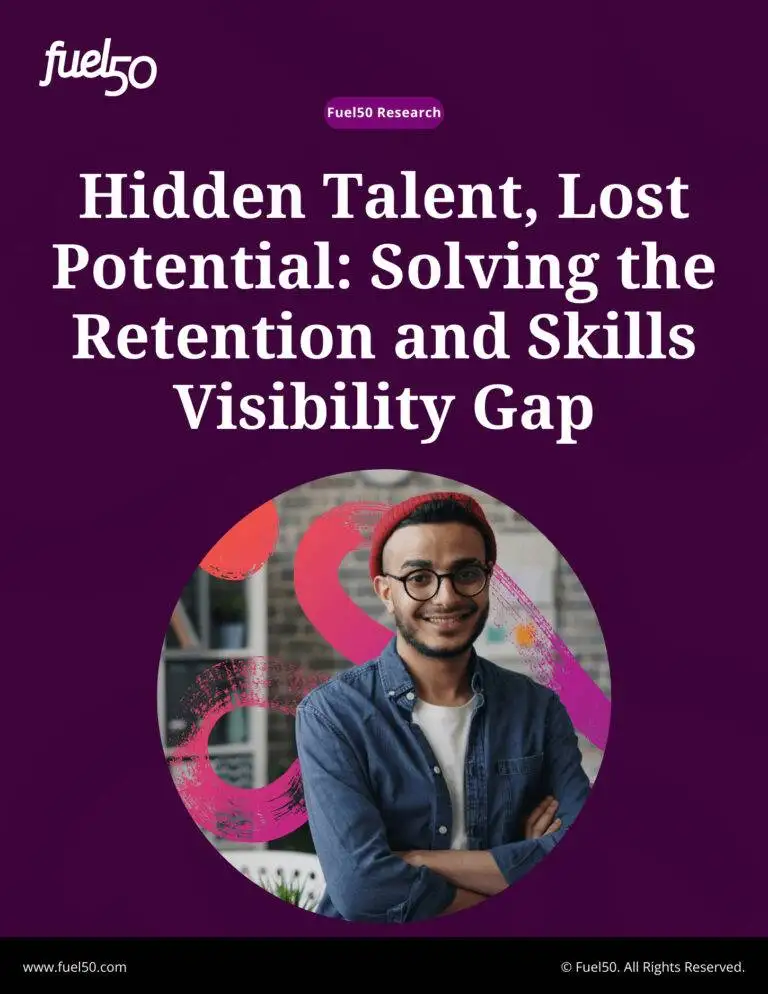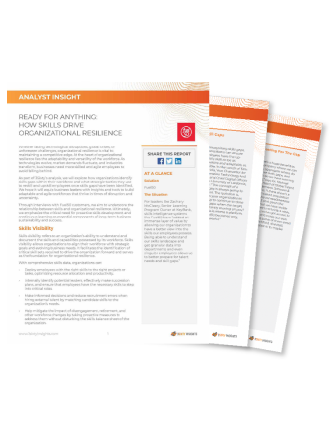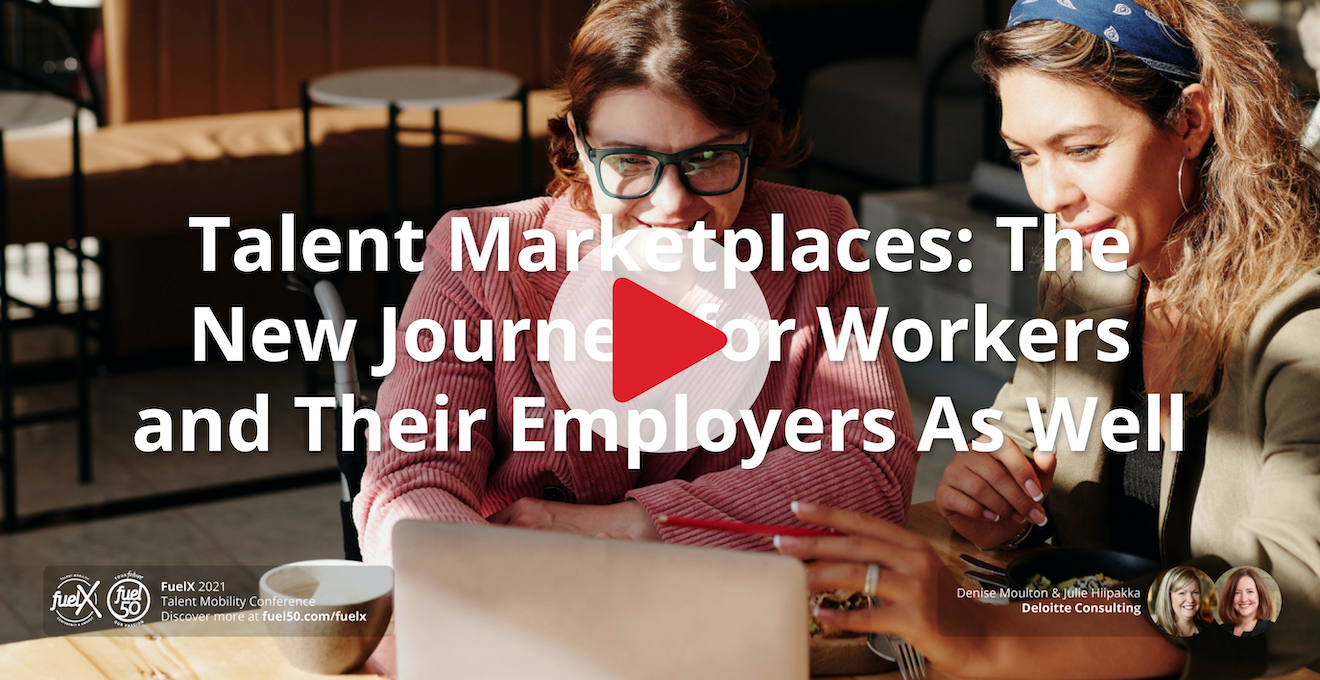Last year, well-known HR technology analyst Josh Bersin made the case that “the talent marketplace has arrived” and that “opening up internal opportunities is of the most powerful management practices in business.”
Deloitte Vice Presidents Denise Moulton and Julie Hiipakka dug into just how spot-on Bersin’s prediction was when they talked about Talent Marketplaces: The New Journey for Workers, at Fuel50’s FuelX Talent Mobility Conference.
You can see their full presentation here, and it is worth watching because they shared a LOT of great information.
Denise Moulton started off by making the case for talent marketplaces — that is, investing in your own workforce — saying:
“Organizations know if they want strategic execution, they’ll need the right people in the right teams. Sounds pretty simple, right? Well not really, because finding the right people continues to be an evergreen struggle, and so many organizations continue to overlook their greatest source of talent — their own workers.
And in a world where 97% of respondents in our recent Global Human Capital Trends Report say they are thinking about transforming work, and 41% go on to say they’re prioritizing building workforce capabilities, it seems a bit surprising to me that only a little over one-half of organizations indicate that they are ready to take an active pivot towards reskilling and helping people find new roles.
For me, that’s a problem, but it’s also a wonderful opportunity for the deployment of a talent marketplace.“
Helping employees take charge of their career
Still not clear about the talent marketplace concept? Denise defined it like this: A talent marketplace is a technology-enabled platform or system that utilizes artificial intelligence to empower employers and employees to connect skills and interests to the right opportunities.
“My entire career has been spent making matches with people,” she said. “The marketplace is also an innovative and flexible approach to talent acquisition, to workforce mobility, and to work management. And consider this: most organizations today recognize that their workers can likely contribute more than their current roles and responsibilities might imply.”
Talent marketplaces enable the mutually beneficial deployment of talent — through which individuals can match their capabilities, interests, and preferences with available work, and teams can identify cross-functional talent to support their specific needs.
She also noted that marketplaces help people find work beyond their network, and when a marketplace is well designed, it builds ways for people to construct a better network and collaborate more with the larger team environment.
Denise described how talent marketplaces help to empower employees like this:
With a talent marketplace, “(employees) have individual agency to find the right role, without any fear of repercussion for wanting something more. It’s actually encouraged. You want to grow? Absolutely — we’re gonna help you do that. And taking charge of their career journey becomes not something that’s only done with the high performers or those who are really aspirational, but it can happen for everybody.”
Talent marketplaces offer big benefits, including reskilling
As with most things in life, a talent marketplace not only offers benefits for workers who want to build and grow their careers but for the larger organization as well. It is also a critical element to help drive a supportive and highly productive company culture.
One element that is currently driving the move to a talent marketplace is the need many organizations have to reskill or upskill their current workforce.
Julie Hiipakka described it like this:
“When you think about talent marketplaces … they provide some powerful things not just for organizations, but also for workers. And one of those opportunities on both sides of the house relates to a really hot topic right now, which is reskilling.
Workers recognize that the half-life of skills is decreasing, and organizations are recognizing this all over — so much so that I think we are having a lot of conversations with our clients about becoming skills-based organizations. Everybody is seeing that skills are expiring and expiring rapidly, and when that’s happening, everybody wants a way to evolve and adapt. There are a couple of ways that we encourage workers and organizations to think about that …
- The first is this: what do people need right now? What do I need you to do to support the work that I’m doing right now in my job that might have changed, whether it’s something as simple as my company has rolled out a new virtual meetings tool, or as complicated as I’m still in this job but my company has decided to open a new line of business and so there’s this whole area of things that I need to get smart about?
- Then there’s ‘what do I need to do to grow in the role that I’m in?’ So sure, we might be opening up this new line of business, and that’s going to change my role somewhat, but what do I really need to know beyond today in order to help that new business rollout to be successful?
- And then there’s this longer-term question — ‘where is my career really going? And what do I really need in order to grow in it?’ which sometimes we feel like we only get to talk about with our people managers, or our life coaches, or occasionally our friends and family …”
It’s questions like these that make reskilling (or its cousin, upskilling) an important element of talent marketplaces today. People can’t grow unless their skills grow, and organizations know that they will need to embrace more learning for employees as a key part of their marketplace.
But, what about talent hoarding?
If there is an Achilles heel in the talent marketplace model, it usually comes down to this — talent hoarding.
This is a problem that Gallup’s State of the American Workplace report identified back in 2017, and what they said then is just as applicable today:
“Why don’t employees see a future with you? The problem may be with your managers. Your managers — knowingly or unknowingly — may be hoarding your top talent. As a result, they may be inadvertently sending your best people to your competition.”
Talent hoarding happens when managers don’t embrace a key element of the talent marketplace, and that is the basic principle that you will lose employees to another organization if you prevent them from moving to another assignment that allows them to grow their skills and experience somewhere else in the company. When employees lose out because their current leader is only focused on their own needs and ignore the impact on both the employee AND the larger organization, everybody loses. In fact, it’s the stereotypical no-win or lose-lose situation.
Denise Moulton shared some insight into avoiding talent hoarding and why managers must put their trust in their organization’s talent marketplace:
“We really want to look at developing and getting away from a talent hoarding culture. … Talent hoarding can actually contribute to disengagement, talent hoarding can contribute to extremely high attrition, talent hoarding is horrible for the brand of your organization, and for tech talent acquisition, too.
Talent hoarding happens. We’ve written extensively about this because of a lack of faith and trust, that if you let your top performer go, they’re not going to be replaced quickly enough. We need to change the narrative. And we can. (With) the talent marketplace, we’re really helping to manage the supply and demand of talent differently. …
Once you start to streamline some of these internal hiring practices, you start to also develop this incredible trust with your entire organization. TA and talent teams need to be fully integrated and understand who’s up and coming, who’s moving, who’s shifting, who’s growing. It’s a virtuous cycle. And if you watch it carefully, you’ll know how to manage (talent) more effectively. You’ll create a cycle that equals growth, a cycle that equals excitement, and not a cycle that results in disengagement and attrition.”
Final thoughts
There is a reason why talent marketplaces have become a big deal in the past year; it’s because leaders everywhere have found that growing, building, and retaining your own organizational talent is better – and more cost-effective — for employees, managers, and company culture, too.
In a post-pandemic world where recruiting new talent gets harder and more costly, a talent marketplace offers a way for leaders to improve their workforces for the greater good of the organization AND for the betterment of employees as well.
Denise Moulton talked about how the Deloitte research and data spelled this out:
“The talent marketplace really can offer something for everyone. For workers, we’ve talked about it. It’s all about growth and opportunity. For the organization, it actually can help manage resources in a scalable way.
Think about the supply and demand challenges we have with talent in the marketplace. You can really start to mitigate some of those challenges and be more thoughtful about how you’re moving folks throughout the organization. A marketplace is really that total talent ecosystem that keeps us all together in service of a unifying goal — which is about performance, worker performance, everybody’s performance…
When it’s done well, the internal mobility marketplace may help remove some of those barriers to workers seeking new opportunities or looking to change roles. It will also help support filling open roles in a quicker, more efficient fashion. And as internal hiring practices become more streamlined, organizations can be a lot more deliberate and start to focus on cultivating their internal talent pool as a matter of practice, not by chance or by accident.”














